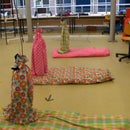Introduction: Cheap Portable Chroma Key Screen (Bluescreen)
This Instructable is about how to build your own cheap portable chroma key screen (bluesceen).
More information about this project here.
Koos, The Make Class
Willem de Kooning Academy Rotterdam
http://blog.wdka.nl/make
Step 1: Parts, Tools & Links
SHOPPINGLIST
# Blue or green material, 2 x 2 meter - 5~10 Euro
Use a good blue or green color! More information about this on Wikipedia. I bought my material on the market. Think about light reflection and stretching!
# 4x tubes 2 meters - 15~20 Euro
I used 4 centimeter waterconducts.
# 4x bended (corner) tubes - 5 Euro
Also used for waterconducts.
# Hard PVC glue - 6 Euro
For the waterconducts.
TOOLS
# Scissors
# Sewing-machine
# Needles
HELPFUL TOOLS
Please read before you start a lot of information about chroma keying.
# Wikipedia
Step 2: Building the Frame
Building the frame is easy. Make a square from the tubes and mount them with each other with the corner piece.
To make it stronger you can use glue to mount the corner piece. Mount on two tubes to each side the corner piece with glue. Not on all tubes, because it still got te be portable :)
Step 3: Preparing the Material
This step is about preparing the material for the sewing-machine. To get a good and strong result you'll have to use a sewing-machine. If you have never done this before, look around if some will help you with this.
Some tips:
- Find someone with some experience to help you.
- Use needles!
- It will help if you stick some parts rough together, remove this after you sticked it again with a sewing machine.
1)
My material was 8 x 1.5 meter. So I had to cut it in pieces to get 2 x 2 meter. Part one has size 2 x 1.5 meter and part two 2 x 0.55 meter (5 centimeter extra for the seam). Use needles to make it one part.
2)
Now we have to create a border at each side to make it strong. Fold 10 cm at each side to a 3~4 centimeter border. Use again needles. At the end the size of the whole screen will be 1.80 x 1.80 meter.
3)
From the rest material you can make strokes. With these strokes you will be able to attach the screen to the frame. I cut it in 64 strokes, each 10 x 25 centimeter. This sounds maybe a lot, but I got on each side 8 attach strokes for optimal span. I fold each stroke to a 3 x 25 centimeter stroke. Don't attach these already to the main materiaal (screen).
The preparing is done!
Step 4: Stick It Together With the Sewing-machine
Now you can stick all your prepared material together with the sewing-machine. If you have never done this before (like me) ask someone to help you. Make some tests on old material before you start.
1)
First, Stick the main (screen) material together. Second, stick the folds on the border. The main (screen) material is done now. You can remove all needles and rough sticks.
2)
It's now time to stitch the strokes. Warning: This is a lot of work! :)
3)
If you are done with both you can attach the strokes to the main (screen) material. To do this:
- Place every time two strokes on each other, and then stick it with needles on the back of the main (screen) material.
- If you placed all strokes on the right place with needles, you can stick it with a sewing-machine.
The sewing-machine work is done, attach it to the frame!
Step 5: End Result
If you have attached the screen material to the frame you will have something like the pictures below.
Good luck with chroma keying! ;)
My teacher Theodore Watson wrote quick in openFrameworks a live keying tool for the presentation, you can see this at the last picture below.













